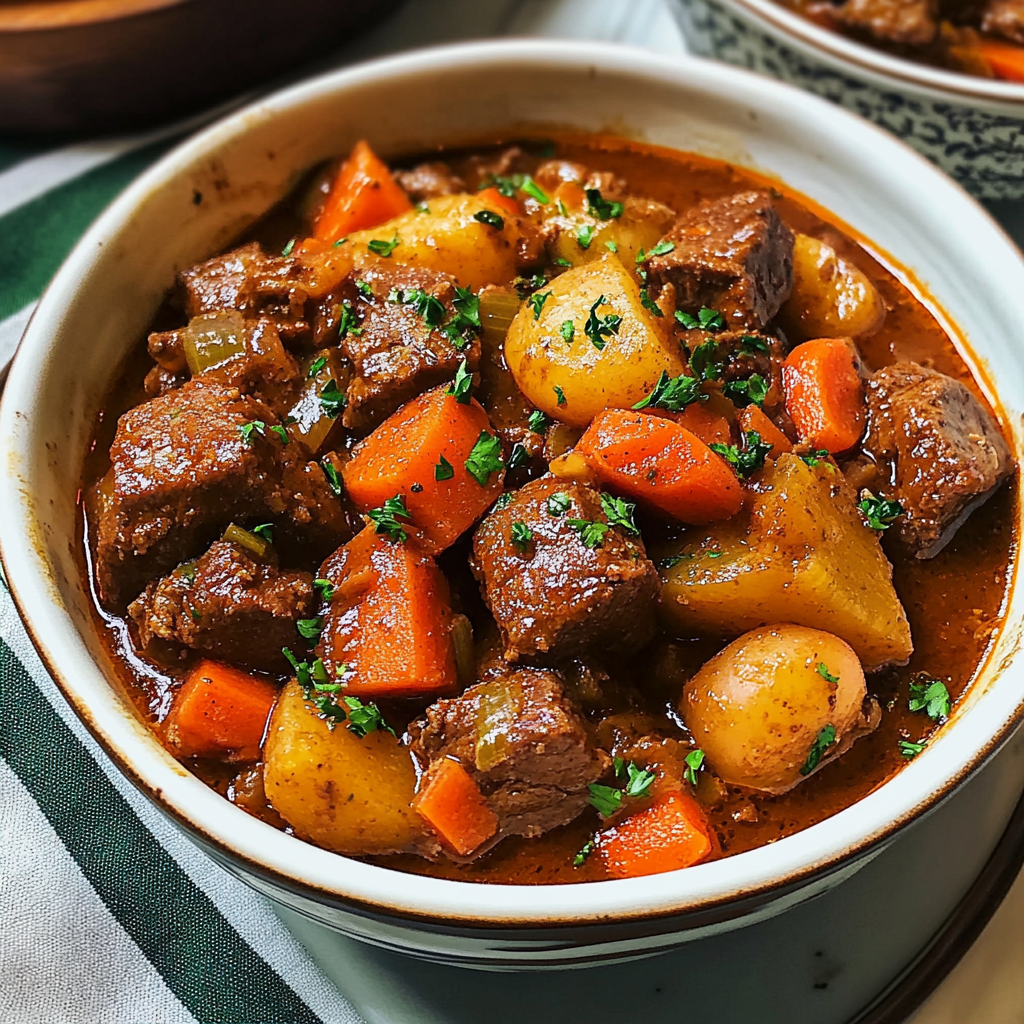Introduction to Beef Stew
There’s a reason why beef stew has stood the test of time—this humble dish is the epitome of comfort food. With tender chunks of slow-cooked beef, hearty vegetables, and a rich, savory broth, it warms both body and soul. From family dinners to cold-weather cravings, beef stew is a staple in kitchens around the world.
What makes it so beloved? It’s not just the flavor—it’s the versatility. You can keep it traditional or spice things up with regional twists. Whether it’s a classic French boeuf bourguignon, an Irish stout-infused version, or a simple rustic pot, each variation delivers the same cozy satisfaction.
This dish is also budget-friendly, easy to prepare, and perfect for make-ahead meals. It’s no surprise that many home cooks return to it time and time again. In this guide, we’ll show you exactly how to make the perfect beef stew—flavorful, tender, and unforgettable.
Choosing the Right Cut of Beef
For the perfect stew, always go for tougher cuts that break down over time and become melt-in-your-mouth tender. Great examples include:
- Chuck roast
- Brisket
- Bottom round
Want something with more variety? Try dishes like the beef and pepper rice bowl for another beef-based favorite that uses similar cooking principles.
🍳 The Stewing Process – Low and Slow
Browning the beef before stewing helps lock in flavor. This essential Maillard reaction adds a rich, umami base that takes your dish from good to unforgettable.
Once browned, combine your aromatics, vegetables, and broth. For a similar cozy texture and richness, you can also explore recipes like split pea soup that showcase hearty, slow-cooked depth.
Classic Ingredients You’ll Need
Here’s your checklist for a traditional beef stew:
- Chuck roast (cubed)
- Potatoes
- Carrots
- Celery
- Garlic
- Beef broth or red wine
- Thyme, bay leaves, and rosemary
If you’re looking for a lighter but still flavorful variation, try the zucchini soup for a vegetable-forward take.
Regional and International Variations
Though the classic beef stew is beloved for its simplicity, different cultures have developed their own versions, adding unique ingredients and techniques that reflect their culinary heritage. These global interpretations show how one dish can wear many flavorful faces.
🇫🇷 Boeuf Bourguignon (France)
A luxurious version of beef stew, this French classic uses red wine, bacon, mushrooms, and pearl onions. The result is a rich, slow-cooked stew often served over buttered noodles or mashed potatoes.
🇮🇪 Irish Stew
Traditionally made with lamb or mutton, this version can also feature beef. It’s hearty and rustic, loaded with root vegetables and often simmered with a splash of Guinness stout for extra depth.
Kaldereta (Philippines)
A tomato-based stew made with beef, liver spread, olives, and cheddar cheese. It’s tangy, creamy, and often served with steamed rice. The use of spicy peppers adds a delicious kick.
🇰🇷 Galbi-jjim (Korea)
A sweet and savory short rib stew braised with soy sauce, garlic, ginger, and Asian pears. Though it’s usually made with ribs, you can easily adapt it using beef chunks.
Caribbean Beef Stew
Infused with bold spices like thyme, allspice, and scotch bonnet peppers. This island-style stew is vibrant and often cooked with coconut milk and root vegetables like yams.
Each variation brings something special to the table, proving that beef stew is a global comfort food icon.
Pair it with homemade naan bread for a satisfying and filling meal.

What to Serve With Beef Stew
A steaming bowl of beef stew is satisfying on its own, but pairing it with the right sides can take it to the next level. Whether you want something to soak up the broth or complement the rich flavors, here are some tasty ideas.
Classic Sides:
- Crusty bread or homemade naan for dipping
- Buttered egg noodles for a rustic, filling twist
- Mashed potatoes—perfect for ladling stew right on top
- Steamed white rice or wild rice for a gluten-free option
Fresh Pairings:
- A simple green salad with a zesty vinaigrette helps balance the richness.
- Pickled vegetables or coleslaw add a tangy contrast.
🍷 Beverage Pairings:
- A dark ale or cider for cozy pub-style vibes
These pairings transform your beef stew into a comforting, well-rounded meal.
If you like soul food vibes, check out Louisiana red beans and rice as another deeply flavorful dish to rotate with your stew night.
How to Add Your Own Twist
One of the best things about beef stew is how easy it is to customize. Whether you’re aiming for a unique flavor profile or adapting it to dietary needs, there are plenty of ways to make it your own.
🌿 Flavor Upgrades:
- Add a smoky kick with chipotle peppers or smoked paprika.
- Use fresh herbs like parsley, tarragon, or dill before serving.
- Stir in a splash of balsamic vinegar or a spoonful of mustard for brightness.
Ingredient Swaps:
- Swap potatoes with sweet potatoes, turnips, or cauliflower for a low-carb version.
- Use mushrooms, parsnips, or butternut squash for extra texture and flavor.
- Prefer a leaner stew? Go with turkey thighs or chicken as protein alternatives.
Experimenting keeps your beef stew exciting every time you make it—and there’s no wrong way to enjoy it.
❄️ Storing, Freezing, and Reheating
One of the best things about beef stew is how well it stores and improves in flavor over time. In fact, it often tastes even better the next day as the ingredients continue to meld.
Storage:
- Refrigerate leftovers in an airtight container for up to 4 days.
- Allow the stew to cool to room temperature before sealing.
❄️ Freezing:
- Freeze in individual portions or family-size batches for up to 3 months.
- Use freezer-safe containers or heavy-duty freezer bags.
- Leave some space in containers for expansion.
🔥 Reheating:
- Reheat on the stovetop over low heat for the best texture.
- In a rush? Use the microwave in short bursts, stirring in between.
- Add a splash of broth or water to loosen the consistency if it thickened in storage.
This makes beef stew perfect for meal prep, busy weeknights, or make-ahead dinners.
Common Mistakes to Avoid
Even the most comforting beef stew can go wrong if a few key steps are missed. Here are common pitfalls to watch out for:
- Skipping the sear – Not browning the beef reduces flavor depth.
- Overcrowding the pan – Leads to steaming instead of searing.
- Overcooking vegetables – Add softer veggies later to avoid mushiness.
- Under-seasoning – Always season in layers throughout the cooking process.
- Too much liquid – Aim for a thick, hearty texture, not soup.
Avoiding these mistakes ensures your beef stew turns out flavorful, balanced, and deeply satisfying every time.
Health & Nutrition Facts
While beef stew is often thought of as a hearty indulgence, it can actually be a balanced and nutritious meal when made with the right ingredients. A typical serving of homemade beef stew (about 1½ cups) contains approximately:
- 350–500 calories
- 25–35g of protein
- 15–25g of fat
- 20–30g of carbohydrates
The exact numbers depend on the cut of beef, amount of added fat, and type of vegetables used. Using lean beef, like bottom round, and adding more fiber-rich veggies can lower the fat content and boost nutritional value.
Stews made with low-sodium broth and plenty of vegetables are also great for heart health. Want to reduce calories further? Skip the flour-based roux and thicken your stew with pureed veggies instead.
Best of all, beef stew is naturally gluten-free (if flour is omitted), making it suitable for a variety of diets. Discover beef stew health benefits
Final Tips
- Don’t rush the cook time. Beef stew needs at least 2 hours to become fork-tender.
- Use wine or dark beer to build flavor.
- Add vegetables in stages to avoid mushiness.
For another fun twist on hearty, spoonable meals, try potsticker soup—unexpected, but still deeply satisfying.
❓ FAQs
❓ What is the secret to tender beef stew?
The key is low and slow cooking. Using tougher cuts like chuck roast allows the collagen to break down, resulting in melt-in-your-mouth tenderness.
❓ How long should I simmer beef stew?
Aim for at least 2 hours on low heat. The longer it simmers, the richer the flavor and the softer the meat.
❓ Can I make beef stew without wine?
Absolutely. Replace wine with beef broth, balsamic vinegar, or tomato paste for depth without alcohol.
❓ What vegetables work best?
Carrots, potatoes, onions, and celery are classics. Add parsnips, peas, or mushrooms for variety.
❓ How can I naturally thicken my stew?
Try reducing the broth, using mashed potatoes, or stirring in a cornstarch slurry.
❓ Is it better the next day?
Yes! Like most stews, beef stew tastes even better after resting overnight as the flavors deepen.



